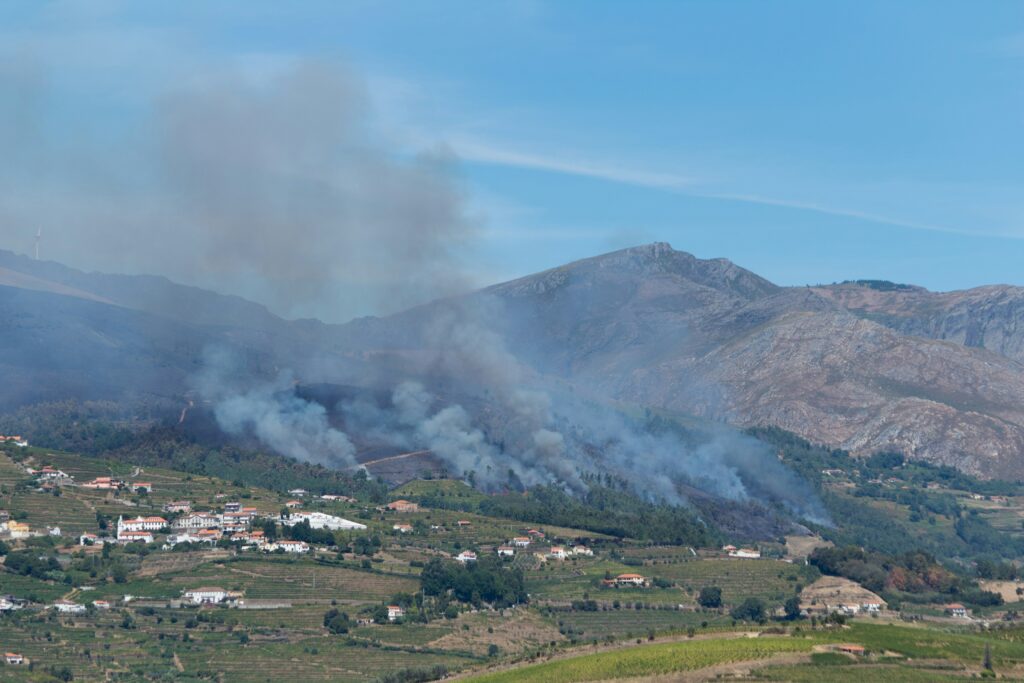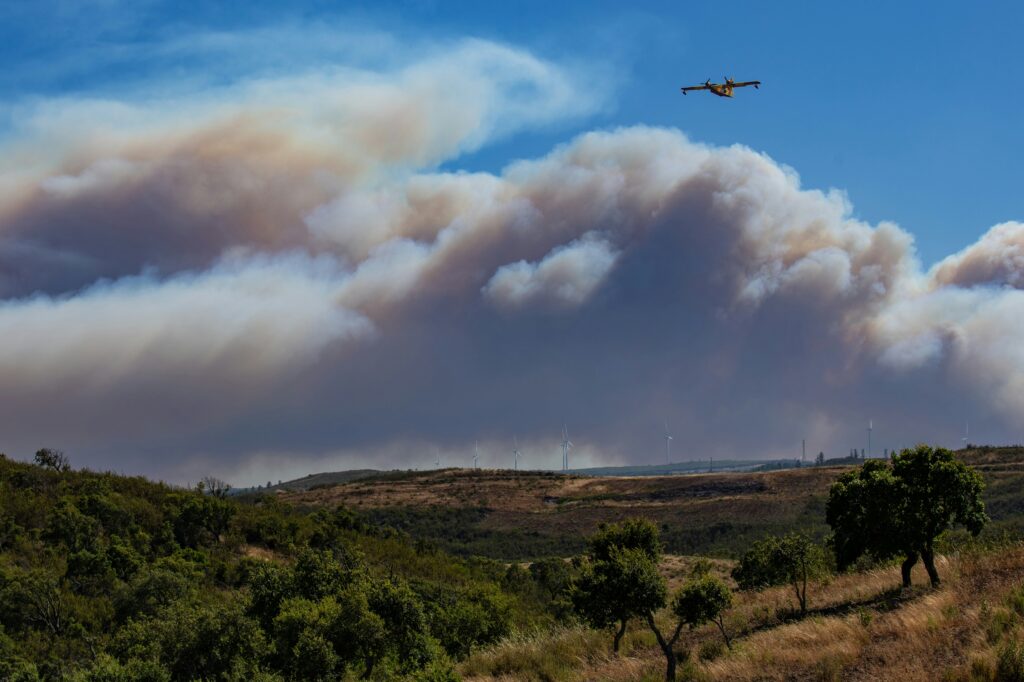Resisting Portugal’s Burning Summers
This year’s unprecedented wildfires spanned the Iberian Peninsula, pushing Europe into its worst fire season on record. Projects like RESIST show how resilience can rise from the ashes.
By late August 2025, nearly one million hectares had burned across the European Union, the largest area destroyed since satellite records began in 2006. That is almost half the size of Sicily, or about one percent of the entire Iberian Peninsula consumed by flames. Spain and Portugal bore the brunt, accounting for more than two-thirds of the EU’s total burn area. To put the numbers in perspective, Spain lost more than 380,000 hectares, roughly six times the long-term seasonal average. Portugal, smaller yet densely forested, saw more than 263,000 hectares destroyed, nearly eight times the area of Malta.
The worst fires clustered in northern Portugal and across north-western Spain, tearing through Galicia, Asturias and Castile and León. National parks, pilgrimage routes and rural towns were left in ruins. Portuguese villages such as Arganil and Malhada do Rei were evacuated as fire lines advanced. In Spain, thick smoke blanketed stretches of the Camino de Santiago and choked people.
When climate and crisis collide
Scientists point to a clear driver. Researchers have found that climate change has made fire-friendly conditions across southern Europe up to ten times more likely. Extreme heat dries out vegetation, turning landscapes into a tinder box ready to catch fire from a lightning strike, a machine spark, a cigarette, or even arson. The cycle then feeds on itself: when forests burn, they release huge amounts of carbon dioxide, which warms the atmosphere further and increases the chances of more fires. In Spain alone, this year’s fires emitted an estimated 17.68 million tonnes of CO₂, more than Croatia’s entire emissions in 2023.
Climate change is only part of the problem. As people leave rural areas, the traditional land management that once shaped and protected these landscapes is disappearing. In the past, farmers and foresters maintained natural breaks in vegetation through varied land use. Now, abandoned fields merge into continuous stretches of dried-out biomass, while dense pine plantations leave little space between tree canopies. When fire arrives, it spreads quickly.

Prevention from the ground up
Against this backdrop, Portugal is turning to prevention that blends ecology, governance and technology. The EU-funded RESIST project is piloting solutions in Central Portugal, focusing on the Coimbra and Médio Tejo regions, with research at the Polytechnic Institute of Portalegre.
The starting point is pragmatic. Where pine plantations press up against villages, the risk of tragedy spikes. In Mestras, a hamlet in the municipality of Góis, residents have worked with local authorities to create a 100-metre safety ring. It is a productive firebreak rather than a barren belt, designed to thin flammable vegetation, encourage native broadleaf species, and reintroduce patches of agroforestry. Research published in October 2025 shows that diversifying tree species in a landscape reduces fire risk. The aim is to slow fire spread, protect lives and property, and stitch biodiversity back into a simplified forest.
Where pine plantations press up against villages, the risk of tragedy spikes.
Filipe Moreira of the Góis forestry department describes the approach simply. Around Mestras, the village condominium manages roughly a 100-metre perimeter that matches municipal fuel-management rules. Species composition and structure are adjusted to lower flammability and defend the settlement. Residents have felt the difference. “People feel more secure,” says Luís Filipe Rodrigues, vice-president of Mortágua’s municipal chamber. “They wanted prevention and protection for their community.” He frames it as more than a technical fix. “The project inspired a new way of being and communicating, because people were working toward the same goal, everyone’s safety.” Mortágua’s economy has long been tied to the forest, and that identity remains. “The forest is the flagship of the economy in this territory,” he says.
The scale also matters. Jorge Brito, executive secretary at CIM Região de Coimbra, says the plan is to create about 152 hectares of protective strips around population centres in the region, each 100 metres wide. By mid-project, about 61 hectares had been implemented. The schedule foresees work in six villages this year, six next year, and two in the final year. “By the end, we will have a measurable increase in resilience,” Brito says.
In Médio Tejo, intermunicipal secretary Jorge Simões points to complementary measures. Two dedicated forest brigades focus on preventive silviculture, fuel management and control of invasive species. Their work sits inside an intermunicipal climate action plan that mixes awareness, owner engagement and direct intervention in reforestation and maintenance. The practical side is never far away. “We are doing fuel management around villages, cleaning and making places safer,” says Sisenando Leitão, a forest firefighter with CIM Médio Tejo. Machinery helps. “Without the robot and the tractor, we would have more difficulty meeting objectives.”
Breaking fire pathways
Prevention depends as much on organisation as on cutting trees. In central Portugal, land is divided into many small plots with different owners, so action is hard unless someone brings them together. RESIST supports Integrated Areas of Landscape Management, known by the Portuguese acronym AIGP, that cover more than 100 hectares. These are participatory structures that gather owners, municipalities and technical teams to agree on land uses, reshape forest edges, and bring back mixed systems that interrupt fire pathways.
Prevention depends as much on organisation as on cutting trees.
“ForestWISE’s role is to bridge research and practice,” says José Gaspar, chief technology officer at CoLAB ForestWISE. “We transfer knowledge from our research into concrete situations on the ground.” Senior researcher Sandra Valente underlines the social architecture that makes the work stick. “When territories have many different owners, participatory methods are even more relevant. We need strategies to get people talking and deciding by consensus. Intervening through village condominiums and integrated landscape areas requires collaboration and a shared understanding of the future of the territory.”
The idea of village condominiums shows a basic truth: if neighbours don’t act together, a few neglected plots can put everyone at risk. That’s why some towns are setting up local boards to help residents decide what to do, plan upkeep, and link private efforts with community safety.

Turning forest fuel into renewable energy
It might be surprising, but risk reduction also has financial benefits. While there is a cost to removing biomass from forests, it becomes a valuable raw material that can be converted into energy, biofuels, and other products. At the Polytechnic Institute of Portalegre, Professor Paulo Brito coordinates a demonstration biorefinery that takes mixed woody biomass and converts it into renewable gas. The process starts with pre-treatment to harmonise moisture and particle size, then moves through conversion routes that produce biogas for multiple uses, such as electricity generation, heating, and transport fuel. One option under study is to power the transport that collects biomass from the field, creating a small closed loop. The aim is not to take rural towns off the grid, but to supplement local energy use with biofuel while making fuel-load reduction financially viable in places where margins are thin.
The aim is not to take rural towns off the grid, but to supplement local energy use with biofuel while making fuel-load reduction financially viable in places where margins are thin.
Local officials link economic renewal to long-term stewardship. In Mação, vice-president Vasco Marques argues that projects like RESIST can bring back a forest that serves people and nature. “It is essential for climate and environment and to avoid desertification,” he says. “The forest must be good for communities and the territory, profitable and environmentally friendly.”
What comes next
Portugal’s 2025 fire season showed what happens when climate pressure meets abandoned land, and how prevention can work. Break up fuel around villages, replace it with native trees or farmland, organise landowners, and keep fire crews active all year. The payoff is clear: fewer evacuations, fewer homes lost, fewer days under orange skies.
However, the wider context is still serious. Europe is paying a rising bill for climate impacts, and the health burden from heat is already counted in lives, especially among older people. The science is clear on the cause. The choices now are about scale and pace. Portugal’s pilots in Coimbra and Médio Tejo are designed to create a spillover effect. Solutions are already being shared with Extremadura in Spain and with Baixo Alentejo in southern Portugal. Knowledge moves faster than firetrucks.
Still, prevention requires steady finance, durable institutions and public trust. It also requires patience. A ring of broadleaf trees planted today will not stop next summer’s flames. It will help the year after, and more the year after that.
